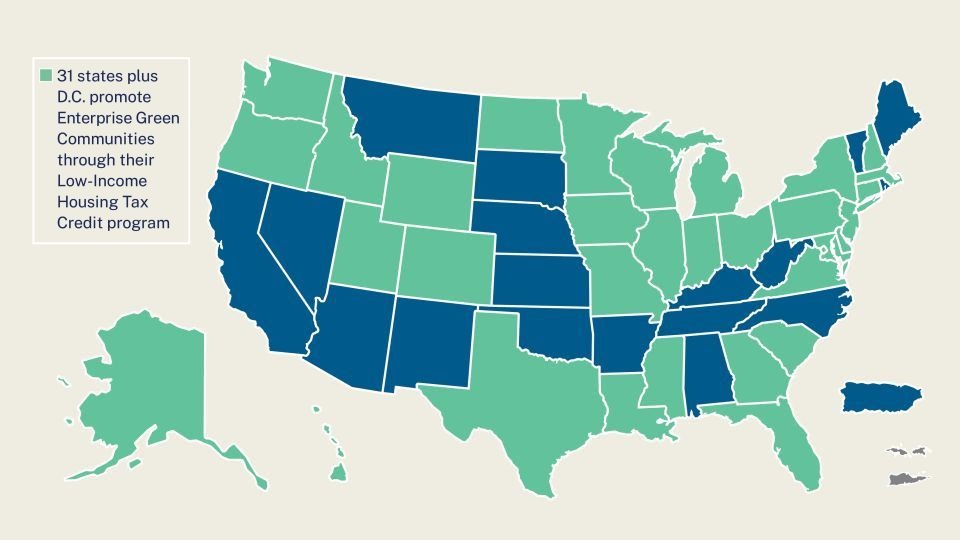

Blog
We’re sharing the strategies we use most often as Enterprise Green Communities consultants to achieve certification and create more sustainable communities.

Access to sustainable and healthy buildings should be a universal right. Unfortunately, underserved communities and low-income families often face significant barriers to living in buildings that are efficient, supportive, and resilient.
The Enterprise Green Communities (EGC) certification program provides criteria to create sustainable, healthy, and affordable housing and offers a pathway our industry can use to advance equity in the built environment.

Thirty-one states, plus Washington, DC, require or encourage developers seeking affordable housing funding to follow the Enterprise Green Communities Criteria.
However, any housing development in the U.S. with affordable homes can earn the Enterprise Green Communities certification. (Projects that achieve the 2020 EGC certification also receive WELL certification.)
In this blog post, we’re sharing the strategies we use most often as EGC consultants, along with a common challenge and solution, to achieve certification and create more sustainable communities.
One of the critical criteria pursued by EGC projects is energy efficiency. To achieve this criterion, our strategy involves implementing high-performance building envelope measures, energy-efficient systems, and renewable energy solutions. Together, these measures can significantly reduce energy consumption and lower utility costs for residents.
A common challenge is the upfront cost of energy-efficient systems, which can hinder affordable housing. Limited budgets and financial constraints can make investing in the aforementioned measures difficult.
To overcome this challenge, our consultants work closely with project teams to identify available incentives, grants, and financing options that can offset these costs. For example, a recent project secured funding through a state-sponsored energy efficiency program, enabling the installation of a highly efficient HVAC system for low-income housing.
Indoor air quality plays a crucial role in creating healthy and sustainable housing. The focus of EGC is implementing proper ventilation systems, using low-emitting building materials, and conducting air quality testing. These measures ensure that residents have access to clean and healthy indoor environments, reducing the risk of respiratory issues and improving overall wellbeing.
EGC also emphasizes using non-toxic building materials and proper ventilation to promote good indoor air quality.
Maintaining good indoor air quality in affordable housing can be challenging due to factors such as building design, occupant activities, and potential sources of indoor pollutants. Limited ventilation options and a lack of awareness about indoor air quality issues can contribute to poor air quality.
Additionally, selecting low-emitting building materials within budget constraints and ensuring their proper installation requires coordination between project teams and suppliers.
Ongoing monitoring and maintenance are crucial to sustaining healthy indoor environments for residents.
Water efficiency is an essential component of sustainable housing. Our strategy focuses on reducing water consumption through low-flow fixtures, efficient irrigation systems, and rainwater harvesting. By incorporating water-saving measures, we conserve vital resources and lower utility costs for residents. EGC highlights the importance of water-efficient fixtures, landscaping, and irrigation systems to minimize water consumption.
Achieving water efficiency in affordable housing projects can be challenging due to outdated plumbing systems, limited access to water-efficient fixtures, and difficulties in changing water usage behaviors among residents.
To overcome this, one solution can be to develop educational campaigns that provide information on the benefits of water conservation and practical tips for reducing water consumption.
Additionally, we collaborate with property management teams to implement water monitoring systems and provide residents and operations and maintenance (O&M) staff real-time feedback on water usage and identify possible leaks.
Finally, ensuring the proper installation and maintenance of water-efficient fixtures is essential to realize long-term water savings and overcome the challenge of potential leaks or malfunctioning equipment.
Selecting environmentally friendly and non-toxic building materials is critical for creating sustainable housing. Our strategy involves identifying products with third-party certifications for sustainability and health attributes, such as GREENGUARD or FloorScore. Using these materials can minimize the environmental impact and improve indoor air quality for residents.
A common challenge in materials selection is the limited availability and higher cost of sustainable building products. To address this, our consultants work closely with teams to identify manufacturers and suppliers who promote the development of affordable options. Through partnerships with local vendors, teams can successfully source cost-effective, sustainable materials.
Promoting health and wellness within affordable housing projects is vital to sustainable communities. EGC recognizes the significance of creating spaces that prioritize the wellbeing of residents.
This strategy involves incorporating features to enhance occupants’ overall health, such as access to natural light, proper acoustics, and opportunities for physical activity, as well as creating environments that support physical and mental wellbeing, including recreational spaces, access to nature, and designs that foster a sense of community.
Additionally, addressing residents’ diverse health and wellness needs can pose a challenge. Affordable housing projects serve individuals and families with varying backgrounds, ages, and health conditions. It is essential to consider the specific needs and preferences of the community to ensure that the health and wellness features implemented are inclusive and beneficial to all residents.
Creating spaces that support the physical and mental health of all residents may require innovative solutions and careful planning to optimize available resources.
Together, let’s create a future where everyone has access to sustainable and affordable housing. We can drive positive change in underserved communities by implementing strategies focused on energy efficiency, indoor air quality, water efficiency, materials selection, and health and wellness.
As we continue our commitment to sustainable housing, it’s essential to stay informed about changes in the EGC program, explore how cities incorporate EGC into laws and building codes, and understand potential overlaps between EGC criteria and other certification programs.
If you’re interested in learning more about our sustainable housing initiatives or have any questions about EGC, please visit our contact page.
If you’re looking for some project examples, visit these profiles:
Contributor: Giulia Luci, Senior Sustainability Consultant
Steven Winter Associates